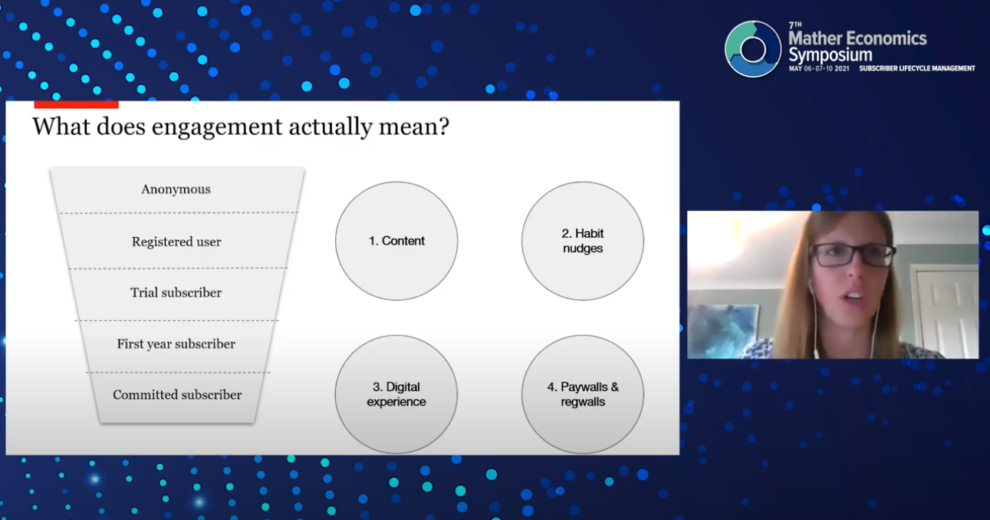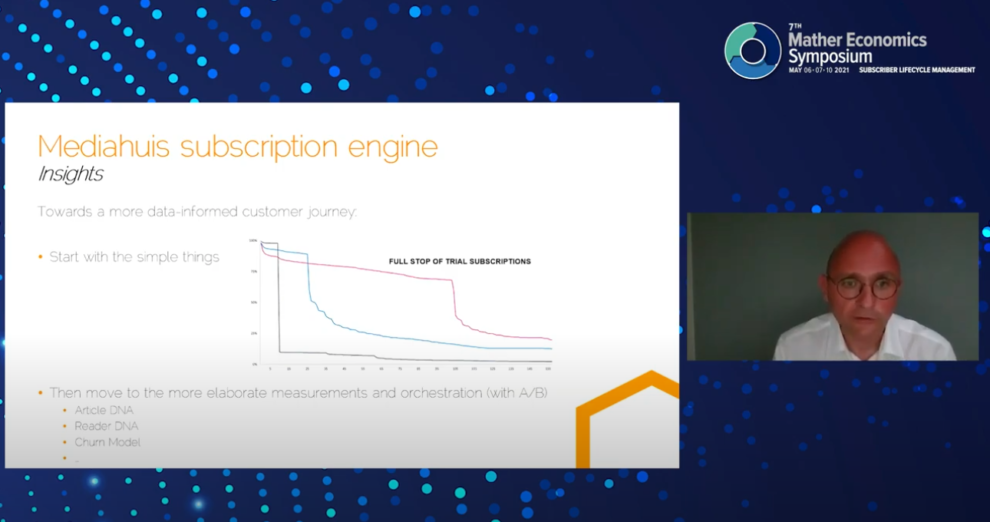In the 3 day symposium, Mather Economics tackled the topic of “Subscriber Lifecycle Management”. This is a further endorsement to the growth in importance of subscribers for publishers.
We selected some of the most noteworthy cases from McClatchy, Mediahuis, Gannett, and The Economist looking at the topics of culture, customer centricity, technology, and subscription strategy.
A subscription business starts with the right culture
The increasing popularity of digital products has forced business plans to adjust their focus on digital rather than print needs. Ensuring the right people are on board following the right culture is therefore vital for this success.
For Mediahuis, this involves working with “A-People”. Hiring and mixing the right people is essential. These people need to not only be passionate and result-driven, but also eager to learn and flexible. They have adapted their team structure from “functional” to “Swiss Army Knife” teams to ensure agility.

At Mediahuis this is particularly important in their acquisition strategy. When a new publisher joins the group, they leverage the local knowledge of pre-existing staff and look at how they can make a difference by bringing in external teams.
When it comes to the digitalisation of newsrooms, Tony Hunter, Chairman & CEO of McClatchy explained that this can be seen more as an opportunity than a bad thing. McClatchy used digitalisation to prepare and readjust the focus of the business. They asked themselves “what do we aspire to be?”.
This resulted in a new 1-pager plan that Hunter explained was designed to be simple. This simplicity therefore can allow everyone in the company to play a role.
The next step was to assess the culture and diversity of the team. Hunter argued that for McClatchy, it was time to turn this talk into action. Inside McClatchy, this new culture and diversity ensures that everyone is in a position to help and contribute. This gave them a newfound level of what Hunter described as “orga-gility”: the ability to drive new ideas to implementation rapidly and to pivot frequently. Behind all this change, the mission on McClatchy has never changed. They still aim to provide news to people in local markets.

From audience attention to customer obsession
With the plethora of free and paid news products on offer, understanding customer demands is more important than ever. Dutch publisher NRC (part of Mediahuis) went the extra mile in doing this. They went to visit subscribers at their houses to find out what the newspaper meant for them.
Short of doing this, putting the customer as the centre-point of a publishing business is logical. At The Economist, this is done by focusing on customer lifetime value. At each stage of the funnel, The Economist focuses on 4 elements: content, habit nudges, digital experience, paywalls and registration walls. This ensures that customers are getting the best possible experience. After all, the more engaged a customer is, the more likely they are to pay.

This shift to focus on audiences has also started taking place at Gannett. For Chief Marketing and Strategy Officer Mayur Gupta, whilst this customer-focused strategy plays an important role, it should not infringe on their culture. Customer focus should be reflected in both culture and strategy.
Gupta explained that they have shifted from obsessed with audience attention to obsessed their customers. Internally, this has been reflected through a shift to focus on user value over user traffic. They want to inspire customers to pay by making quality products that are worth their while.

Part of this focus has been driven by a shift from being campaign focused, to always on. Vital to this focus is recognising that customers don’t have a start and end date, but in fact, they’re always there. To maintain this always on mindset, the team at Gannett are constantly listening, testing and engaging. This is driven by the fundamental belief that the longest surviving brands have culture and a connection with their audience.
At McClatchy customer focus is at the heart of their experiments. A key goal is to strategically manage the transition of subscribers and advertisers from print to digital. They want to drive both advertisers and customers to having the best possible experience to ensure future satisfaction.
Don’t be afraid to experiment with digital pricing
Pricing remains a hotly contested issue in publishing: daring to experiment is everything for publishers.
In a significant strategic shift, 2020 saw The Economist stop selling print-only subscriptions. All print subscribers were given the digital package for free on top of their subscription. This print/digital bundle is now the sole option alongside digital only.
Claire Overstall, Global Head of Customer at The Economist, explained that this was something that had been long discussed, however it was ultimately driven by COVID-19. The pandemic meant that The Economist were unable to deliver print-editions to certain countries, therefore they had to adapt and offer them digital access. Interestingly despite this new bundle, Overstall added that they have not seen a large drop from print customers to digital.
On top of this, The Economist offered a new daily COVID-19 article free of charge to non-subscribers to enable them to access the most important news. This, alongside webinars accessible to free trialists and registered customers, has seen an overall increase in subscriptions over 2020. More specifically, the webinars have created a 7% increase in trialists converting into first year subscribers.
After recent experimentation, Mediahuis scrapped free trials at NRC as part of their strategy. Instead, they offered long-term offers to subscribers. This enabled Mediahuis to measure how effective different subscription offers have been.

Since then, long-term offers have been matched with pure long-term subscriptions. The long-term focus was a big shift in business. Through their research however, they found that this was a great way to increase engagement rates and habits. Whilst this long-term strategy has been effective for Mediahuis, Verwilt warned the symposium that long-termism may not be the answer for everyone. Instead, Verwilt added that publishers should act with caution and experiment first.
Tony Hunter from McClatchy echoed this sentiment. He explained that pricing is an empirical issue which must be based on testing. After internal experimentation, McClatchy found that they were too passive and conservative with digital pricing. Through experimentation, McClatchy found that they could increase their prices by 79% and lose just 4.6% of subscribers.
McClatchy aim to give value to subscribers through better products. By “doubling down” on their core competencies, they believe that they can differentiate themselves from their competitors. McClatchy’s key competencies include the quality and understanding of their content. Through their strategical content focus, they aim to position themselves as key providers. They hope that people will feel that they must subscribe so they can visit their sites daily for essential news.
Focus on journalism. Build strong partnerships for the rest.
With more options than ever being present in the digital market, it is more important than ever to stand out. Some publishers choose to keep this tech-focus internal whilst others prefer to use external parties.
Mediahuis have recently switched from an internal tech team to external partnerships. This enables them to worry less about technological issues and focus more on journalism. As a hub of many legacy publishers, this focus on the journalism is essential. Mediahuis COO Paul Verwilt told the symposium that this focus on journalism enables them to externally invest around €70 million annually on technology.

At McClatchy, technology plays an essential role in their effort to transition readers and advertisers from print to digital. A good digital product is a must-have to make this transition easier. The team at McClatchy hope that technology will help them grow in the industry and become an essential part of people’s daily lives. Through this technological focus, they hope to make their local news products a must-have.
Meanwhile, The Economist have embarked on this journey internally. They have chosen to grow their product team. This is a particularly important area for The Economist due to the role of audio at the publisher.
Audio is one of the tools that drives the highest engagement at The Economist and helps them to stand out. This audio comes not just in the form of podcasts but also in the form of audio articles. The ability of readers to listen to articles has always been key for Economist subscribers. The Economist have several different teams all focused on different areas of the tech-journey, including engagement and conversion.
Valuable partnerships are at the heart of our work here at Twipe. To learn more, get in touch with our team!
